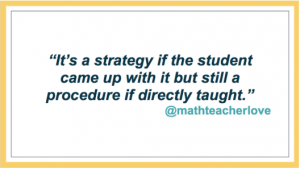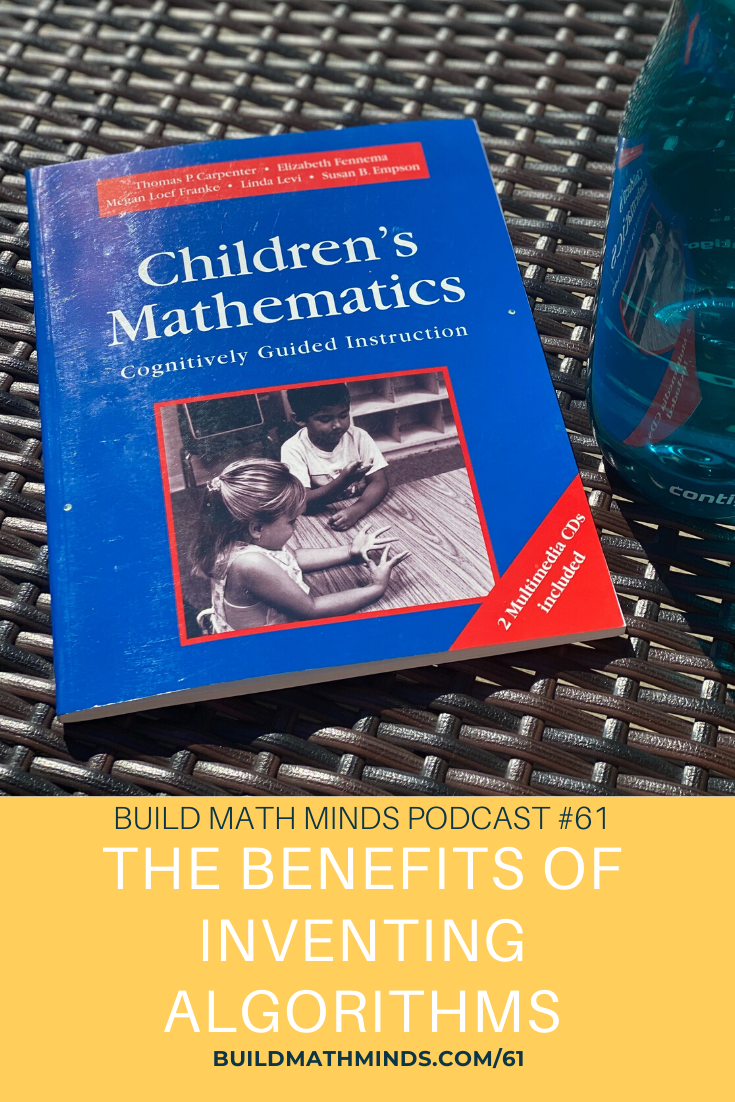Resources mentioned in this episode:
Watch the limited-time replay of the 3 Keys To Building Elementary Students’ Math Fluency webinar
Cognitively Guided Instruction: A Knowledge Base for Reform in Primary Mathematics Instruction article by Carpenter, Fennema, and Franke
Children’s Mathematics: Cognitively Guided Instruction by Thomas P. Carpenter, Elizabeth Fennema, Megan Loef Franke, Linda Levi, and Susan B. Empson
@mathteacherlove on Instagram
Welcome fellow Recovering Traditionalists to Episode 61. Today we are looking at The Benefits of Inventing Algorithms.
This past weekend I did a webinar each day that thousands of elementary educators attended. It was the same webinar just different days/times to allow for people’s scheduling. If you didn’t get a chance to attend you can still catch the limited-time replay for the next few days at buildmathminds.com/replay. The webinar was all about how to help kids develop their own ways of solving problems and not be reliant upon algorithms or strategies taught by the teacher.
My first glimpse into teaching math in this way was through the research of Thomas Carpenter, Elizabeth Fennema, and Megan Frank-e (1996). Then their book, Children’s Mathematics: Cognitively Guided Instruction came out and gave me even more insight into opening up my teaching through the use of story problems to allow children’s thinking to help guide my instruction.
I talked about this book way back on Episode 1 of this podcast, but today I’d like to share a different part of the book with you. Back in Episode 59, I shared about the harmful effects of algorithms, but today I’d like to share with you the Benefits of Inventing Algorithms. Some of us call these invented algorithms “strategies,” but the CGI researchers call them invented algorithms.
On page 74 (of the first edition of the book) they write:
“When children invent their own algorithms, they often avoid some of the more serious misconceptions that children exhibit when they try to imitate symbolic manipulations that someone else shows them. This is not to say that children’s invented algorithms are always correct, but when children invent algorithms for themselves, they have some basis for understanding and correcting their errors.
The standard written algorithms have evolved over centuries to be efficient methods for calculation. But the efficiency comes at a cost. The algorithms are not very transparent: It is not clear why they work. Children’s invented algorithms are based directly on their understanding of base-ten grouping concepts. They are not isolated procedures. Children talk about combining fifty and thirty or five tens and three tens, rather than adding numbers in the same column. What may be lost in efficiency is more than made up in the fact that invented algorithms are more conceptual and consequently less likely to foster serious misconceptions and errors.”
One of the issues with this “new math” is that kids are being taught all these different strategies or ways of solving problems, but they are just symbolic manipulations to many of the kids. They have not invented the strategies. They are just following steps and procedures that the teacher has taught them.
As Emily from @mathteacherlove over on Instagram told me

If we are going to directly teach them procedures then let’s just go back to one procedure. We have way too many kids who are getting confused by all these different ways to solve problems.
Now I don’t believe we should go back to just teaching them one procedure. I really believe in Cognitively Guided Instruction, letting the students’ cognitive thinking drive our instruction. We need to let the kids develop their own strategies, or algorithms.
But how do we help those kids who don’t naturally invent their own algorithms without directly teaching them? We focus on developing the root system of place value and number sense, which I talk about in that free webinar. When we focus on those two things, our students’ flexibility with numbers grows. When they become more flexible thinkers, they start inventing their own algorithms.
PLUS, these algorithms (or strategies) are ones that the child built, so like they said in the book, the kids are less likely to have misconceptions or errors or mix up steps. Focus on building kids’ number sense and place value understanding and incorporating more activities (like teaching through story problems) that allow kids to discuss and talk about their mathematical thinking…the byproduct will be that kids will create their own strategies that work for them and not just be manipulating symbols on paper…they will be thinkers.
If you want to learn more about how to do that, again you can go watch the free webinar, buy the Children’s Mathematics book, or maybe even come join me inside the online Number Sense course that I do for elementary educators. Registration is open right now but only for a few more days. You can go check that out at buildmathminds.com/enroll.
Stay safe and stay mentally healthy.
These episodes are sponsored by the online trainings that I do for elementary educators. I have online Number Sense courses that thousands of teachers have gone through. Number Sense 101 is for PreK – 2nd grade educators and Number Sense 201 is for 3rd – 5th grade educators. These courses help you understand the foundation of number sense, how it impacts students’ ability to become fluent in mathematics, and how to help your students build their number sense. Registration for the courses we’ll be opening soon. Go to buildmathminds.com/enroll to learn more about each course.
Subscribe and Review in iTunes
Hey, are you subscribed to the Build Math Minds Podcast, yet? If you’re not, make sure to do that today because I don’t want you to miss any episodes! Click here to subscribe to the podcast in iTunes.
While you’re there, don’t forget to leave a review on iTunes too. I would love to know your thoughts and how we can make sure that we give you content that you will really enjoy.
To leave a review, head over to iTunes and click on “Ratings and Reviews” and “Write a Review.” I can’t wait to hear your thoughts about the podcast.




